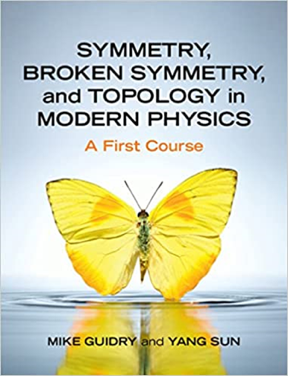

Recently, a new textbook, Symmetry, Broken Symmetry, and Topology in Modern Physics: A First Course, coauthored by Professor Mike Guidry of University of Tennessee at Knoxville (UTK) and Professor Yang Sun of Shanghai Jiao Tong University (SJTU), is published by the Cambridge University Press. Written for use in teaching and for self-study, this book provides a comprehensive and pedagogical introduction to groups, algebras, and topology that are typically found only in very specialized literature. It assimilates modern applications of these concepts, assuming only an advanced undergraduate preparation in either mathematics or specialized fields of physics. For the first time, these advanced mathematical topics are systematically included into undergraduate physics textbook. The publication of this book is a successful cooperation between Chinese and American scholars, and may represent a breakthrough in textbook reform in high education with the participation of Chinese scholars.
Undergraduate physics majors today take classes and participate in research experiences that expose them increasingly to more advanced mathematical topics that they will encounter in many research fields if they continue on to graduate school. In the SJTU School of Physics and Astronomy, for example, under the compulsory curriculum "Physics Research Practice", nowadays all students participate in scientific research during the undergraduate period. It is very useful that young students majoring in physics and related fields begin to learn about the first-class scientific research at the early stage of their studies. However, there is one set of topics and associated mathematics of increasing importance for various research disciplines that undergraduates (and even many graduate students) are seldom exposed to in any systematic fashion.
Why is this so? Is it an essential problem generated by the topics being inherently too difficult to teach effectively before graduate school, or is it more a problem associated with the lack of pedagogical materials to enable them to be taught easily to advanced undergraduate physics majors?
The coauthors of this book are themselves instructors in their respective universities in China and the United States; both have taught undergraduate classes for many years. Professor Mike Guidry works at UTK for over 40 years. During his career, he has won multiple teaching awards and has taken the lead in a variety of science outreach initiatives. At SJTU, Professor Yang Sun has for more than 10 years taught "Quantum Mechanics" to students at the School of Physics and Astronomy and the Zhiyuan College. He is the author of more than 250 journal articles, mainly in the field of nuclear many-body theory, but also in other correlated fermionic systems. Professor Sun often discusses and exchanges teaching experiences with Professor Guidry for the same question: how to guide advanced undergraduates to frontier fields of the world-class research.
Based on their experience in teaching and research, they believe that the major impediment to being able to teach these concepts systematically to undergraduates is not that it is too difficult for the students, but rather it is the scarcity of pedagogical material for instructors that would make teaching such a course feasible within the usual undergraduate curriculum. Although there are many good book and journal article resources around the world available on the general topics of groups, algebras, topology, and geometry as applied in modern physics, few if any address these topics in a coherent and cross-disciplinary fashion that is deliberately pitched at an audience having advanced undergraduate preparation and broad scientific interests. The present book is a step toward filling that gap.
The book is written based on lectures that the coauthors taught initially over a number of years to graduate students, and many of their own research articles on applying Lie algebras and Lie groups to a variety of many-body systems. The material has been systematically reorganized, rewritten, and supplemented by additional pedagogical material to make it intelligible to undergraduate students. The book is divided into 34 sections in 4 parts: "Symmetry Groups and Algebra", "Symmetry Breaking", "Topology and Geometry", and "Various Physical Applications". An example-based approach is adopted from the outset, and the book includes worked examples and informational boxes to illustrate and expand on key concepts. 344 homework problems are included, with full solutions available to instructors, and a subset of 172 of these problems have full solutions available to students.
The core of high education reform is teaching materials. One may thus view the present book as an attempt to do something to enable systematic teaching of some advanced mathematics and their modern physics applications to new generations of undergraduate students. It is hoped that this book will help physics majors, when they go to graduate school, with enough mathematical preparation and solid understanding of modern physics, to start their most interesting and challenging research.
This book was written during the 2020-2021 COVID-19 pandemic. The authors especially thank family, colleagues, students and friends for their support and encouragement during this most difficult time.
Related Links:




